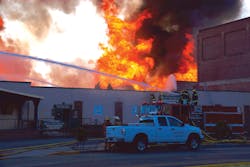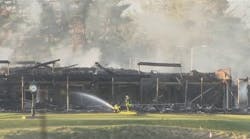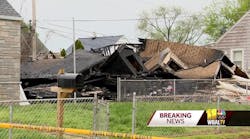Eighty-four firefighters from 13 departments in three counties responded to a four-alarm fire that destroyed a warehouse under renovation in downtown Wenatchee, WA, on Saturday, June 20, 2009. Workers in another building reported hearing an explosion and saw flames and heavy smoke on the roof of the warehouse. During the incident, challenges involving fuel for apparatus, depleted manpower and fireground safety provided lessons for incident managers.
The Hamilton Warehouse building, built in 1917, was a former cold storage warehouse with a brick exterior lined with clay-type tiles. The interior floors were posted-up heavy beams, with the beams often measuring 12 by 20 inches or more, in a type of platform construction independent of the walls. The floors on the northern two-thirds of the building were two-by-sixes nailed flat-side together for a six-inch-thick solid floor covered in many areas with quarter-inch, four-by-eight-foot sheets of steel due to forklift wear. The southern third was formerly office space and the floors were of lighter construction. The walls and separations were insulated with one foot of wood shavings, reportedly cypress shavings to resist rot. The roof was a flat, built-up roof.
The building was purchased from Stemilt Growers in September 2008 by the Hamilton Investment Group. This warehouse was similar to the Go USA building adjacent to the warehouse with a common wall on the north side of the fire building. The Go USA building was renovated beginning in 2000 by the Hamilton Investment Group and is about three-quarters occupied. The Hamilton Investment Group was in the process of a similar project at the former Stemilt warehouse. The Hamilton Warehouse consisted of 100,000 square feet with a full basement, first floor and second floor consisting of 30,000 square feet each and a 10,000-square-foot third floor on the northern end of the building.
Because of the renovations, temporary electricity was supplied through a hole in the common wall between buildings. The gas had been shut off to the building. Demolition contractors were in the building the week prior to the fire performing clean-up work in preparation for the necessary upgrades to convert the space to mixed office and commercial space. There were no fire detection or protection systems in the building at the time of the fire.
Initial Operations
The Wenatchee Fire & Rescue Department was dispatched to a reported commercial fire at the Hamilton Warehouse at 524 South Columbia St. at 5:52 A.M. The fire was first reported by two employees working in the Building Supply Outlet, a large block building across the alley to the west of the Go USA building. The employees reported hearing an explosion and rushed outside to the alley to investigate. Heavy smoke and flames were reported from the roof at the old Stemilt Warehouse building south of the Go USA building.
Wenatchee Fire & Rescue Engine 41, a 1,250-gpm pumper with a crew of three; Ladder 42, a 100-foot quint aerial with a 1,250-gpm pump and three firefighters; and Command 40 with Battalion Chief Mitch Barnes responded. Automatic mutual aid from Douglas County Fire District 2 was also dispatched. Engine 221 a 1,500-gpm pumper with a three-person crew, and Command 22 with Assistant Chief Doug Miller responded.
Upon arrival, Barnes reported a fully involved structure fire and determined that all operations would be defensive. Barnes established Columbia Street Command and identified side A as Columbia Street. Command was on Spokane Street. Fire was showing on side C from the roof and the alley at ground level. The building was not occupied and there were no life-safety issues.
Engine 41 was the first engine to arrive and was assigned to side D (Spokane Street) and supplied with a 100-foot, four-inch line laid from the hydrant at Spokane and Columbia streets. Firefighters deployed a 200-foot, 2½-inch exposure line with a 250-gpm nozzle and set up in the alley outside the collapse zone to protect the exposure on the west side of the building. Ladder 42 arrived at 6:02 A.M. and was positioned on side B (Chehalis Street) near the B/C corner and adjacent to the alley. Engine 221 laid a 100-foot, four-inch line from Wenatchee Avenue and Chehalis Street to Ladder 42 for supply. Engine 221 was then repositioned to Division C and laid a 300-foot, four-inch line from a hydrant to the north of the fire across the four lanes of Wenatchee Avenue to the front of the building. Engine 221 placed its deck gun into operation with a 1¾-inch tip flowing 1,000 gpm. Firefighters stretched two 100-foot, 2½-inch lines to a 500-gpm monitor on the roof of one of the businesses on side C. Miller was assigned as the incident safety officer.
Second Alarm
Barnes requested a second-alarm commercial response at 5:58 A.M. Chelan County Fire District 1 responded with Engine 11, a 1,500-gpm pumper, and Ladder 11, a 75-foot aerial ladder with a 1,500-gpm pump. Cashmere Fire Department responded with Engine 21, a 1,500-gpm pumper. As second-alarm resources arrived at approximately 6:15 A.M., Chelan County Engine 11 was assigned to side A (Columbia Street). Engine 11 was supplied by a 400-foot, four-inch line and a 2½-inch line from a hydrant at Columbia and Chehalis streets. Engine 11 connected two 100-foot, 2½-inch lines to the sprinkler system fire department connection on the Go USA building, a 70,000-square-foot, three-story, renovated warehouse adjacent to the fire warehouse.
Chelan County Ladder 11 was positioned next to Engine 11 and established aerial master stream operations at the A/D corner of the involved warehouse. Ladder 11 was supplied by Engine 11. Cashmere Engine 21 was assigned to B Division (Chehalis Street) and laid a 200-foot, four-inch hydrant supply from the west side of Wenatchee Avenue for its supply and connected another four-inch line to Ladder 42. Firefighters placed a monitor into operation at the B/C corner of the fire building to assist with exterior exposures of adjacent businesses.
Third Alarm
Barnes requested a third alarm at 6:18 A.M. Several of these departments were one hour away. Responding units included Leavenworth Fire Department Engine 31 and a command unit, a Cashmere Fire Department command unit, Lake Wenatchee Engine 91, Chelan County Fire District 1 Engine 13, Dryden Fire Department Engine 62 and Orondo Fire Department Engine 241. Ladder 71 from the City of Chelan was also requested, but was out of service.
Wenatchee Fire Chief Stan Smoke arrived on scene and assumed command of the incident at 6:29. Barnes was assigned as operations chief. At 6:45, an additional four-inch supply line was laid to Engine 41. The 2½-inch exposure line was replaced with a four-inch supply line to a monitor that had a 13/8-inch tip (500 gpm) for maximum reach. At 6:55, Ladder 11 received a second four-inch line and a 2½-inch line from a hydrant 600 feet north of Columbia Street. Engine 64 and Engine 91 took a hydrant supply 600 feet southeast of the fire building with 2½-inch lines and set up two, 250-gpm monitors on the A/B corner.
At 7 A.M., Division D was established. Rehab was established on the north side of the incident by Ballard Ambulance. In addition to Engine 41, four teams of firefighters were assigned to the division and a rapid intervention team was established as interior teams entered the Go USA building to check and maintain the internal exposure wall. Firefighters were uncertain at the time about the continuity of the wall because building plans called for passageways cut into the warehouse.
The interior teams checked exposure walls in the basement and on all three floors. They found the interior exposure wall in good condition. However, the first interior team located a 16-inch-square breach in the separation wall on the third floor where three temporary 50-amp electrical cables were supplied through the hole in the wall. One firefighter grabbed a bag of mortar from the third-floor construction project and plugged the hole to prevent the fire from spreading into the Go USA building. Another noted exposure issue in the Go USA building was the storage of 4,000 tires in the basement adjacent to the fire warehouse.
As firefighters continued to monitor interior exposures, they began salvage efforts for the businesses in the Go USA building. This building was constantly monitored with a thermal imager and building occupants were led in to cover equipment and remove a large number of servers and computers from a business on the main floor. Damage in this building was limited to light smoke and the sprinkler system was not activated on any floor. There was an inch or less of water in the basement that leaked through, but the cement floor and tire storage there sustained little permanent damage except wet shavings in the common wall.
Walls Collapse
At 7:15 A.M., the first wall collapse occurred on side C. This released a ball of fire, increased the smoke and heat, and sent firebrands to the exposures around the fire warehouse and to the southeast of the fire building with prevailing winds of 10–15 mph to the south-southeast. At 7:50, the southern portion of the A-side wall collapsed and the B-side wall collapsed at 7:52.
Exposures on side A included five power poles and nine transformers that caught fire on Columbia Street. The Public Utility District (PUD) had already cut the power to the main lines in the area and an exposure line from Engine 11 minimized the hazard. Additional side-A exposures included Burlington Northern tank cars that were exposed to heat and firebrands; a PUD power substation; a bulk-storage plant that was showered by firebrands; and the old Stemilt pear-packing warehouse across Columbia Street and to the east of the fire.
The old packaging warehouse is a single-story, below-grade structure with a cement floor, several feet below the grade of the fire warehouse basement. This building measures 300 by 100 feet with an arched roof and was sprinklered with 20-foot ceilings. It had two roll-up and two man doors.
The two warehouses were connected under Columbia Street by four tunnels. The southern tunnel was large enough for forklifts and the 3½-foot northern tunnel housed a conveyor belt. Both tunnels were open and provided air supplies to the fire. Two three-foot-diameter tunnels were in the middle and sealed. The tunnels also acted as a conduit for water to drain from the master-stream appliances focused on the fire, filling the former pear-packing warehouse with 4½ feet of water. Efforts were made during the fire to clear the drains, but they could not keep up with the water flow. This resulted in water damage to four vehicles, a construction trailer, a forklift and a painting contractor's storage area.
At 7:30, Engine 64 and Engine 91 took a hydrant supply 600 feet southeast of the fire building with 2½-inch supply lines and set up two, 250-gpm ground mounts on the A/B corner. At 7:45, spot fires were being reported across the railroad tracks and 200 yards downwind from the fire. The spot fires developed after the roofs began collapsing and embers were pushed by the 10- to 15-mph south winds. Operations established an exposure group headed by Entiat Fire Department Chief Mike Asher that included Brush 11, a Type III wildland unit with 120-gpm pump from Chelan County Fire District 1, and Brush 221, a Type VI wildland unit with a 110-gpm pump from Douglas County Fire District 2. Both brush trucks had arrived in staging at 7 A.M., as volunteers responded from their stations to the fire scene. These units extinguished one pole fire and four brushfires as they patrolled exposures downwind.
General Alarm
At 7:55, firefighting resources were nearly depleted and crews were not able to rotate to rehab. At 8 A.M., Smoke requested a general alarm for manpower and requested an additional aerial apparatus from Ephrata in Grant County. Manpower was requested from Chelan, Entiat, Monitor, Orondo, Peshastin and Waterville. Peshastin Brush 36 and Entiat Tanker 81 responded. Chelan and Waterville were short staffed and unable to respond. Orondo and Monitor had sent all available resources on the initial alarms.
The collapse of the A/B corner wall aided in the suppression efforts and increased the effectiveness of the fire streams that enabled firefighters to gain control of fire between 8:30 and 9 A.M. At 9 o'clock, Ephrata Ladder 2195, a 95-foot aerial platform with a 2,000-gpm pump, arrived on scene with five firefighters and was set up on the A/B corner to replace the ground monitors that were in operation. It was supplied by three 2½-inch lines from multiple hydrants.
Smoke declared the fire under control at 10 A.M. Aerial and ground master streams were continued for an additional three hours before demobilization of mutual aid departments began.
Fourteen engines and three aerials were used to fight the fire. Eight hydrants on the municipal water system supplied 3.3 million gallons of water that was used during suppression operations. The Wenatchee Regional Water Department monitored the regional water system and assisted by opening a valve and turning on additional pumps to meet the demand. The total water flow capacity between the aerial apparatus, ground monitors and handlines ranged between 6,000 gpm to 6,500 gpm from 7:30 to 9 A.M.
The building continued to burn in areas on Saturday and crews maintained the scene and extinguished small fires throughout the weekend. Hot spots surfaced and were extinguished during the week that the federal Bureau of Alcohol, Tobacco, Firearms and Explosives (ATF) National Response Team was conducting its cause-and-origin investigation. The building was purchased in 2008 for $970,000 and insured for $3.1 million. The temperature was in the 70s during the fire. There were no injuries.
A six-day, on-site investigation was conducted by 25 members of the ATF team and 15 regional investigators from Wenatchee Fire & Rescue, Douglas County Fire District 2, Chelan County Fire District 1, and the Ephrata, Moses Lake and Quincy fire departments.
The warehouse construction, heavy fire load and sawdust insulation created a challenging fire scene. The investigation revealed that smoke was smelled, but discounted on Friday, June 19, at 4 P.M., 16 hours before the first 911 call reporting the explosion and fire. The predominant theme on firefighter observation reports was that the fire had been burning for some time. The earliest photos show fire on three floors. Early investigator photos, at 6:30 A.M., show that the fire had burned out a boarded-up window in the basement on the east side. During the investigation, a 12-by-20-inch beam in the northwest stairway, wrapped in metal, was consumed for 14 of its 16-foot length. Other areas of the solid floor were burned through.
The first reported collapse was at 7:15 A.M., one hour and 15 minutes after arrival, of one of the brick walls in the midsection on the west side. This fire clearly had an unusual head start as well as a significant fire load due to construction materials. When coupled with the tunnels for an air supply, the fire burned intensely. Saving the exposures was considered second to life safety, a main objective and efforts from all the responding units succeeded.
ATF cause-and-origin specialist Dane Whetsel determined that one of the temporary electrical power cords that ran into the basement caught under a three-foot insulated door at the foot of the stairway in the northwest corner of the warehouse. The cord overheated and was the heat source at the point of origin of this fire. After their determination of cause as accidental, the scene was released by ATF and the Wenatchee Fire & Rescue to the insurance companies and owners of the building at 5 P.M. on June 26. Investigators hired by the insurance companies continued their investigation of the scene, including further analysis of the wire and all evidence seized.
Lessons Learned
Old warehouses are of particular concern to the fire department because of limited access, heavy fire load and wood shavings used for insulation. The great success of this fire suppression activity was the relatively limited damage to exposures considering the huge scale and intensity of the fire.
During the post-incident review, the initial and ongoing operations were reviewed with the responding agencies. The incident management personnel that filled Incident Command System (ICS) roles were asked to discuss their experience by evaluating the clarity of the tactical objectives and assignments given; how their requests for resources were addressed; how their radio communications went throughout the incident; how their personnel accountability was managed; and how the rehab of personnel was managed.
Several problems came up during the incident and provided lessons learned in incident management:
- Apparatus — When the third-alarm aerial was out of service, a request to find another aerial should have gone out immediately. There was also a delay of refueling on-site apparatus when the primary refueling company failed to respond on a weekend. An alternative company was finally identified and dispatched, but one of the aerials had run out of diesel. Early requests and contingency plans for apparatus issues would help avoid these delays.
- Firefighter safety — There were many firefighter safety challenges during this major warehouse fire with the hazards of heavy smoke, extreme heat and building collapse. The positioning of apparatus and personnel were critical. Full personal protective equipment (PPE), clear objectives, responsible supervision, firefighter accountability, functional tactical communications at all levels (radio, visual and face to face), and timely and appropriate rehab of personnel were all important components of safe fireground operations. There were no injuries and hazards and exposures were addressed and handled effectively.
- Incident command — The ICS has been thoroughly adopted and embraced in recent years within the department and with the two closest mutual aid departments, Chelan County Fire District 1 and Douglas County Fire District 2. Outside training has been brought in over the past three years and the lessons learned were put to good use as the command, communications and organization worked exceeding well to maximize and coordinate efforts on this fire.
JAY K. BRADISH/IFPA, Firehouse® news editor, is a former captain in the Bradford Township, PA, Fire Department. He has been a volunteer firefighter and fire photographer for more than 25 years.






